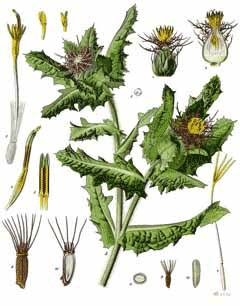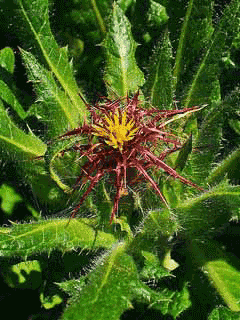 |
|
http://commons.wikimedia.org/wiki/File:Koeh-043.jpg |
 |
| http://commons.wikimedia.org/wiki/File:Cnicus_benedictus_002.JPG |
Translate this page:
Summary
Physical Characteristics

 Cnicus benedictus is a ANNUAL growing to 0.6 m (2ft).
Cnicus benedictus is a ANNUAL growing to 0.6 m (2ft).
See above for USDA hardiness. It is hardy to UK zone 8. It is in flower from May to September, and the seeds ripen from July to October. The species is hermaphrodite (has both male and female organs) and is pollinated by Insects.
Suitable for: light (sandy), medium (loamy) and heavy (clay) soils and prefers well-drained soil. Suitable pH: mildly acid, neutral and basic (mildly alkaline) soils. It cannot grow in the shade. It prefers dry or moist soil.
UK Hardiness Map
US Hardiness Map
Synonyms
Cnicus microcephalus. Cnicus pseudo-benedictus. Epitrachys microcephala
Plant Habitats
Cultivated Beds;
Edible Uses
Edible Parts: Flowers Leaves Oil Root
Edible Uses: Condiment Oil
Young leaves - raw[4, 268]. Flower heads, harvested before the flowers open, have been used as a globe artichoke (Cynara cardunculus) substitute[268]. The flower heads are rather small and using them in this way is very fiddly[K]. Root - boiled as a pot herb[268]. The herb is used as a flavouring[105, 183] (the part that is used is not specified).
References More on Edible Uses
Medicinal Uses
Plants For A Future can not take any responsibility for any adverse effects from the use of plants. Always seek advice from a professional before using a plant medicinally.
Appetizer Astringent Bitter Cholagogue Contraceptive Diaphoretic Diuretic Emetic
Emmenagogue Galactogogue Homeopathy Stimulant Stomachic Tonic VD
The blessed thistle was widely cultivated in the middle ages, when it was seen as a cure-all for all manner of diseases including the plague[238]. Although less widely used nowadays, it is still seen to have a wide range of applications though it is mainly employed as an ingredient in herbal tonics[268]. The whole plant is astringent, bitter, cholagogue, diaphoretic, diuretic, strongly emetic in large doses, emmenagogue, galactogogue, stimulant, stomachic and tonic[4, 7, 9, 21, 165, 207, 222, 268]. A warm infusion of the plant is said to be one of the most effective means of improving the milk supply of a nursing mother[4]. An infusion of the whole plant has also been used as a contraceptive[213] and is often used in the treatment of liver and gall bladder problems[9]. The plant is also used internally in the treatment of anorexia, poor appetite associated with depression, dyspepsia, flatulent colic etc[238]. The whole plant was infused overnight in cold water and the liquid drunk three times daily in the treatment of VD. Men were required to run after each dose in order to encourage sweating. The treatment often caused nausea and vomiting[213] - excessive doses of the plant cause vomiting[7]. The plant is used externally in the treatment of wounds and ulcers[238]. The plant is harvested in the summer as it comes into flower and is dried for later use[4]. A homeopathic remedy is made from the plant[9]. It is used in the treatment of the liver and gall bladder[9]. The German Commission E Monographs, a therapeutic guide to herbal medicine, approve Cnicus benedictus for dyspepsia (indigestion) and loss of appetite (see [302] for critics of commission E).
References More on Medicinal Uses
The Bookshop: Edible Plant Books
Our Latest books on Perennial Plants For Food Forests and Permaculture Gardens in paperback or digital formats.

Edible Tropical Plants
Food Forest Plants for Hotter Conditions: 250+ Plants For Tropical Food Forests & Permaculture Gardens.
More

Edible Temperate Plants
Plants for Your Food Forest: 500 Plants for Temperate Food Forests & Permaculture Gardens.
More

More Books
PFAF have eight books available in paperback and digital formats. Browse the shop for more information.
Shop Now
Other Uses
Oil
A good quality oil is obtained from the seed[4, 61]. It has been used in emergencies when other oils were not available[222].
Special Uses
References More on Other Uses
Cultivation details
Easily grown in ordinary garden soil[1]. Prefers a dry soil and a sunny position[7]. Grows best in a well manured soil[268]. A very ornamental plant, it is often cultivated in Europe as a medicinal herb and for its oil yielding seed[9, 61].
References Carbon Farming Information and Carbon Sequestration Information
Temperature Converter
Type a value in the Celsius field to convert the value to Fahrenheit:
Fahrenheit:
The PFAF Bookshop
Plants For A Future have a number of books available in paperback and digital form. Book titles include Edible Plants, Edible Perennials, Edible Trees,Edible Shrubs, Woodland Gardening, and Temperate Food Forest Plants. Our new book is Food Forest Plants For Hotter Conditions (Tropical and Sub-Tropical).
Shop Now
Plant Propagation
Seed - sow in situ in the spring or early autumn[111]. The seed usually germinates in 2 - 6 weeks at 10°c[164].
Other Names
If available other names are mentioned here
Blessed Thistle, St. Benedict's thistle, holy thistle, spotted thistle, Cardo bendito, Cardo santo, Cristo pobre.
Native Range
TEMPERATE ASIA: Afghanistan, Cyprus, Egypt (Sinai), Iran, Iraq, Israel, Jordan, Lebanon, Syria, Turkey, Armenia, Azerbaijan, Kazakhstan, Kyrgyzstan, Tajikistan, Turkmenistan, Uzbekistan, China (Xinjiang Uygur Zizhiqu) TROPICAL ASIA: Pakistan (north) EUROPE: Albania, Bulgaria, Bosnia and Herzegovina, Greece (incl. Crete), Italy (incl. Sardinia), North Macedonia, Serbia, Spain, France, Portugal AFRICA: Algeria, Libya
Weed Potential
Right plant wrong place. We are currently updating this section.
Please note that a plant may be invasive in one area but may not in your area so it's worth checking.
This plant can be weedy or invasive. It is known to be a noxious weed in South Carolina, USA.
Conservation Status
IUCN Red List of Threatened Plants Status : This taxon has not yet been assessed.

Growth: S = slow M = medium F = fast. Soil: L = light (sandy) M = medium H = heavy (clay). pH: A = acid N = neutral B = basic (alkaline). Shade: F = full shade S = semi-shade N = no shade. Moisture: D = dry M = Moist We = wet Wa = water.
Now available:
Food Forest Plants for Mediterranean Conditions
350+ Perennial Plants For Mediterranean and Drier Food Forests and Permaculture Gardens.
[Paperback and eBook]
This is the third in Plants For A Future's series of plant guides for food forests tailored to
specific climate zones. Following volumes on temperate and tropical ecosystems, this book focuses
on species suited to Mediterranean conditions—regions with hot, dry summers and cool, wet winters,
often facing the added challenge of climate change.
Read More
Expert comment
Author
L.
Botanical References
200
Links / References
For a list of references used on this page please go here
Readers comment
| Add a comment |
|
If you have important information about this plant that may help other users please add a comment or link below. Only comments or links that are felt to be directly relevant to a plant will be included. If you think a comment/link or information contained on this page is inaccurate or misleading we would welcome your feedback at [email protected]. If you have questions about a plant please use the Forum on this website as we do not have the resources to answer questions ourselves.
* Please note: the comments by website users are not necessarily those held by PFAF and may give misleading or inaccurate information.
To leave a comment please Register or login here All comments need to be approved so will not appear immediately.
|
Subject : Cnicus benedictus
|
|
|
|